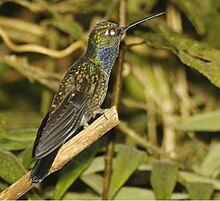Napo sabrewing
| Napo sabrewing | |
|---|---|

| |

| |
| male (above) and female (below) | |
| Scientific classification | |
| Domain: | Eukaryota |
| Kingdom: | Animalia |
| Phylum: | Chordata |
| Class: | Aves |
| Clade: | Strisores |
| Order: | Apodiformes |
| Family: | Trochilidae |
| Genus: | Campylopterus |
| Species: | C. villaviscensio
|
| Binomial name | |
| Campylopterus villaviscensio (Bourcier, 1851)
| |

| |
The Napo sabrewing (Campylopterus villaviscensio) is a Near Threatened species of hummingbird in the "emeralds", tribe Trochilini of subfamily Trochilinae. It is found in Colombia, Ecuador, and Peru.[3][4]
Taxonomy and systematics
The Napo sabrewing is monotypic.[3]

Description
The Napo sabrewing is about 13.5 cm (5.3 in) long. Males weigh 7.4 to 9.3 g (0.26 to 0.33 oz) and females 5.2 to 7.4 g (0.18 to 0.26 oz). Both sexes have an almost straight black bill and a white spot behind the eye. The male's crown is glittering golden green and the rest of its upperparts bronzy green. Its throat and chest are dark violet-blue and the rest of its underparts dark gray with green spots. Its central tail feathers are bronze-green and the rest dark blue. Females have entirely emerald green upperparts and gray underparts. Their tail is blue-green with whitish gray tips to the feathers.[5]
Distribution and habitat
The Napo sabrewing is found from southern Colombia through eastern Ecuador into northeastern Peru as far as San Martín Department. It inhabits humid montane forest, elfin forest, and secondary forest. In elevation it mostly ranges between 1,000 and 1,800 m (3,300 and 5,900 ft) but occurs as low as 780 m (2,600 ft) in southern Colombia.[5]
Behavior
Movement
The Napo sabrewing's movements, if any, are not known.[5]
Feeding
The Napo sabrewing forages for nectar from the understory to the mid-strata of the forest. In addition to nectar it feeds on small insects by hawking from a perch. No details of its diet are known.[5]
Breeding
Napo sabrewings have been noted in breeding condition in October and November, but nothing else is known about the species' breeding phenology.[5]
Vocalization
The Napo sabrewing's song is "a long series of two notes repeated continuously at evenly spaced intervals 'tslip...tseek...tslip...tseek...' or 'trrip...tseek...trrip...tseek'." Its calls include "a single 'chip' or doubled 'chirrip'" that sometimes become a short rattle.[5]
Status
The IUCN has assessed the Napo sabrewing as Near Threatened. It has a "moderately small" range and its unknown population number is believed to be decreasing. The principal threats are mining, logging, and conversion of its forest habitat to agriculture and pasture.[1]
References
- ^ a b BirdLife International (2016). "Napo Sabrewing Campylopterus villaviscensio". IUCN Red List of Threatened Species. 2016: e.T22687090A93139014. doi:10.2305/IUCN.UK.2016-3.RLTS.T22687090A93139014.en. Retrieved 24 August 2022.
- ^ "Appendices | CITES". cites.org. Retrieved 2022-01-14.
- ^ a b Gill, F.; Donsker, D.; Rasmussen, P., eds. (August 2022). "Hummingbirds". IOC World Bird List. v 12.2. Retrieved August 9, 2022.
- ^ HBW and BirdLife International (2021) Handbook of the Birds of the World and BirdLife International digital checklist of the birds of the world. Version 6. Available at: http://datazone.birdlife.org/userfiles/file/Species/Taxonomy/HBW-BirdLife_Checklist_v6_Dec21.zip retrieved August 7, 2022
- ^ a b c d e f Züchner, T. and P. F. D. Boesman (2020). Napo Sabrewing (Campylopterus villaviscensio), version 1.0. In Birds of the World (J. del Hoyo, A. Elliott, J. Sargatal, D. A. Christie, and E. de Juana, Editors). Cornell Lab of Ornithology, Ithaca, NY, USA. https://doi.org/10.2173/bow.napsab1.01 retrieved August 24, 2022
- Articles with short description
- Short description is different from Wikidata
- Use American English from August 2022
- All Wikipedia articles written in American English
- IUCN Red List near threatened species
- Articles with 'species' microformats
- Commons link is on Wikidata
- Campylopterus
- Birds of the Ecuadorian Andes
- Birds described in 1851
- Taxa named by Jules Bourcier
- Taxonomy articles created by Polbot

